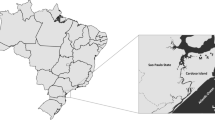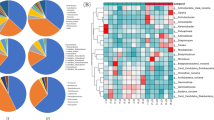Abstract
Soil microorganisms are sensitive to environment disturbances, and such alterations have consequences on microbial diversity and functions. Our hypothesis is that alpha diversity of microbial communities and functional diversity decrease from undisturbed to disturbed soils, with consequences for functional redundancy in the soil ecosystem. To test this hypothesis, we used soil DNA shotgun metagenomics approach to assess the soil microbiome in a chronosequence of land-use from a native tropical forest, followed by deforestation and cultivation of soybean croplands and pasture in different seasons. Agriculture and pasture soils were among the most diverse and presented higher functional redundancy, which is important to maintain the ecosystem functioning after the forest conversion. On the other hand, the ecosystem equilibrium in forest is maintained based on a lower alpha diversity but higher abundance of microorganisms. Our results indicate that land-use change alters the structure and composition of microbial communities; however, ecosystem functionality is overcome by different strategies based on the abundance and diversity of the communities.




Similar content being viewed by others
References
Allison ST, Martiny JBH (2008) Resistance, resilience, and redundancy in microbial communities. Proc Natl Acad Sci U S A 105:11512–11519
Babujia LC, Hungria M, Franchini JC, Brookes PC (2010) Microbial biomass and activity at various soil depths in a Brazilian Oxisol after two decades of no-tillage and conventional tillage. Soil Biol Biochem 42:2174–2181
Balvanera P, Pfisterer AB, He JS, Nakashizuka T, Raffaelli D, Schmid B (2006) Quantifying the evidence for biodiversity effects on ecosystem functioning and services. Ecol Lett 9:1146–1156
Battistuzzi FU, Hedges SB (2009) A major clade of prokaryotes with ancient adaptations to life on land. Mol Biol Evol 2:335–343
Benjamini Y, Hochberg Y (1995) Controlling the false discovery rate—a practical and powerful approach to multiple testing. J R Stat Soc 57:289–300
Borneman J, Triplett EW (1997) Molecular microbial diversity in soils from Eastern Amazonia: evidence for unusual microorganisms and microbial population shifts associated with deforestation. Appl Environ Microbiol 63:2647–2653
Brody JR, Kern SE (2004) Sodium boric acid: Atriz-less, cooler conductive medium for DNA electrophoresis. Biotechnology 36:214–216
Brossi MJL, Mendes LW, Germano MG, Lima AB, Tsai S (2014) Assessment of bacterial bph gene in Amazonian Dark Earth and their adjacent soils. PLoS One 9:e99597
Burke C, Steinberg P, Rusch D, Kjelleberg S, Thomas T (2011) Bacterial community assembly based on functional genes rather than species. Proc Natl Acad Sci U S A 108:14288–14293
Calegari A, Hargrove WL, Rheinheimer DDS et al (2008) Impact of long-term no-tillage and cropping system management on soil organic carbon in an Oxisol: a model for sustainability. Agron J 100:1013–1019
Cenciani K, Lambais MR, Cerri CC, Basilio de Azevedo LC, Feigl BJ (2009) Bacteria diversity and microbial biomass in forest, pasture and fallow in the southwestern Amazon Basin. Revista Brasileira de Ciência do Solo 33:907–916
Certini G (2005) Effects of fire on properties of forest soils: a review. Oecologia 143:1–10
Clark K, Gorley R (2006) PRIMER. Primer-E, Plymouth, UK, version 6
Connel JH (1978) Diversity in tropical rain forests and coral reefs. Science 199:1302–1310
Degens BP, Schipper LA, Sparling GP, Duncan LC (2001) Is the microbial community in a soil with reduced catabolic diversity less resistant to stress or disturbance? Soil Biol Biochem 33:1143–1153
FAO (2012) Food and Agriculture Organization of United Nations. Agriculture and consumer protection department. Conservation agriculture, http://www.fao.org/nr/cgrfa/cthemes/cgrfa-micro-organisms/en//
Fierer N, Ladau J, Clemente JC et al (2013) Reconstructing the microbial diversity and function of pre-agriculture tallgrass prairie soils in the United States. Science 342:621
Fierer N, Leff JW, Adams BJ et al (2012) Cross-biome metagenomic analyses of soil microbial communities and their functional attributes. Proc Natl Acad Sci U S A 109:21390–21395
Fierer N, Bradford MA, Jackson RB (2007) Toward an ecological classification of soil bacteria. Ecology 88:1354–1364
Fierer N, Jackson RB (2006) The diversity and biogeography of soil bacterial communities. Proc Natl Acad Sci U S A 103:626–631
Fisher WD (1958) On grouping for maximum homogeneity. J Am Stat Assoc 53:789–798
Franchini JC, Crispino CC, Souza RA, Torres E, Hungria M (2007) Microbiological parameters as indicators of soil quality under various soil management and crop rotation system in southern Brazil. Soil Tillage Res 92:18–29
Germano MG, Cannavan FS, Mendes LW et al (2012) Functional diversity of bacterial genes associated with aromatic hydrocarbon degradation in anthropogenic dark earth of Amazonia. Pesq Agrop Brasileira 47:654–664
Girvan MS, Campbell CD, Kilham K, Prosser JI, Glover LA (2005) Bacterial diversity promotes community stability and functional resilience after perturbation. Environ Microbiol 7:301–313
Griffiths BS, Ritz K, Bardgett RD et al (2000) Ecosystem response of pasture soil communities to fumigation-induced microbial diversity reductions: an examination of the biodiversity–ecosystem function relationship. Oikos 2:279–294
Hammer Ø, Harper DAT, Ryan PD (2001) PAST: Paleontological Statistics Software Package for Education and Data Analysis. Palaeontol Electron 4:9
Jesus EC, Marsh TL, Tiedje JM, Moreira FMS (2009) Changes in land use alter the structure of bacterial communities in Western Amazon soils. ISME J 3:1004–1011
Kuramae EE, Yergeau E, Wong LC, Pijl AS, van Veen JA, Kowalchuk GA (2012) Soil characteristics more strongly influence soil bacterial communities than land-use type. FEMS Microbiol Ecol 79:12–24
Langenheder S, Bulling MT, Solan M, Prosser JI (2010) Bacterial biodiversity–ecosystem functioning relations are modified by environmental complexity. PLoS ONE 5:e1083
Lauber CL, Ramirez KS, Aanderud Z, Lennon J, Fierer N (2013) Temporal variability in soil microbial communities across land-use types. ISME J 7:1641–1650
Lauber CL, Knight R, Hamady M, Fierer N (2009) Soil pH as a predictor of soil bacterial community structure at the continental scale: a pyrosequencing-based assessment. Appl Environ Microbiol 75:5111–5120
Maeder P, Fliessbach A, Dubois D, Gunst L, Fried P, Niggli U (2002) Soil fertility and biodiversity in organic farming. Science 296:1694–1697
Margulies M, Egholm M, Altman WE et al (2005) Genome sequencing in microfabricated high-density picolitre reactors. Nature 437:376–380
Mendes LW, Kuramae EE, Navarrete AA, van Veen JA, Tsai SM (2014) Taxonomical and functional microbial community selection in soybean rhizosphere. ISME J. doi:10.1038/ismej.2014.17
Meyer F, Paarman D, D’Souza M et al (2008) The Metagenomics RAST server—a public resource for the automatic phylogenetic and functional analysis of metagenomes. BMC Bioinforma 9:386
Navarrete AA, Cannavan FS, Taketani RG, Tsai SM (2010) A molecular survey of the diversity of microbial communities in different Amazonian agricultural model systems. Diversity 2:787–809
Navarrete AA, Taketani RG, Mendes LW, Cannavan FS, Moreira FMS, Tsai SM (2011) Land-use systems affects archaeal community structure and functional diversity in western Amazon soils. Revista Brasileira de Ciência do Solo 35:1527–1540
Navarrete AA, Kuramae EE, de Hollander M, Pijl AS, van Veen JA, Tsai SM (2013) Acidobacterial community responses to agricultural management of soybean in Amazon forest soils. FEMS Microbiol Ecol 83:607–621
Newcombe RG (1998) Improved confidence intervals for the difference between binomial proportions based on paired data. Stat Med 17:2635–2650
Olden JD, Leroy Poff N, Douglas MR, Douglas ME, Fausch KD (2004) Ecological and evolutionary consequences of biotic homogenization. Trends Ecol Evol 19:18–24
Pan Y, Cassman N, Hollander M, Mendes LW, Korevaar H, Geerts RHEM, van Veen JA, Kuramae EE (2014) Impact of long-term N, P, K, and NPK fertilization on the composition and potential functions of the bacterial community in grassland soil. FEMS Microbiol Ecol. doi:10.1111/1574-6941.12384
Parks DH, Beiko RG (2010) Identifying biologically relevant differences between metagenomic communities. Bioinformatics 26:715–721
Philippot L, Spor A, Hénault C et al (2013) Loss in microbial diversity affects nitrogen cycling in soil. ISME J 7:1609–1619
R Development Core Team (2007) R: A Language and Environment for Statistical Computing: Vienna, Austria. (http://www.R-project.org)
Rodrigues JLM, Pellizari VH, Mueller R et al (2012) Conversion of the Amazon rainforest to agriculture results in biotic homogenization of soil bacterial communities. Proc Natl Acad Sci U S A 110:988–993
Sala OE, Chapin FS, Armesto JJ et al (2000) Biodiversity—global biodiversity scenarios for the year 2100. Science 287:1770–1774
SEPLAN. Secretaria de Estado e Planejamento e Coordenação Geral (2001) Mapa de solos do Estado de Mato Grosso, Mato Grosso. Available at: www.seplan.mt.gov.br (last accessed in 25 July, 2011)
Soltani AA, Khavazi K, Asadi-Rahmani H, Omidvari M, Dahaji P, Mirhoseyni AH (2010) Plant growth promoting characteristics in some Flavobacterium spp. isolated from soils of Iran. J Agric Sci 2:106–115
Souza RC, Cantão ME, Vasconcelos ANT, Nogueira MA, Hungria M (2013) Soil metagenomics reveals differences under conventional and no-tillage with crop rotation and succession. Appl Soil Ecol 72:49–61
Taketani RG, Tsai SM (2010) The influence of different land uses on the structure of archaeal communities in Amazon anthrosols based on 16S rRNA and amoA genes. Microb Ecol 59:734–743
Tardy V, Mathieu O, Lévêque J et al (2014) Stability of soil microbial structure and activity depends on microbial diversity. Environ Microbiol Rep 6:173–183
Venter JC, Remington K, Heidelberg JF et al (2004) Environmental genome shotgun sequencing of the Sargasso Sea. Science 304:66–74
Ventura M, Canchaya C, Tauch A et al (2007) Genomics of Actinobacteria: tracing the evolutionary history of an ancient phylum. Microbiol Mol Biol Rev 71:495–548
Wagg C, Bender SF, Widmer F, van der Heijden MGA (2014) Soil biodiversity and soil community composition determine ecosystem multifunctionality. Proc Natl Acad Sci U S A. doi:10.1073/pnas.1320054111
Wittebolle L, Marzorati M, Clement L et al (2009) Initial community evenness favours functionality under selective stress. Nature 458:623–626
Verkhovtseva N, Kubarev E, Mineev V (2007) Agrochemical agents in maintaining the structure of the soil microbial community. Russ Agric Sci 33:100–102
de Vries FT, Thébault E, Liiri M et al (2013) Soil food web properties explain ecosystem services across European land use systems. Proc Natl Acad Sci U S A 110:14296–14301
Yamada T, Sekiguchi Y, Imachi H, Kamagata Y, Ohashi A, Harada H (2005) Diversity localization, and physiological properties of filamentous microbes belonging to Chloroflexi subphylum I in mesophilic and thermophilic methanogenic sludge granules. Appl Environ Microbiol 71:7493–7503
Yachi NH, Loreau M (1999) Biodiversity and ecosystem productivity in a fluctuating environment: the insurance hypothesis. Proc Natl Acad Sci U S A 96:1463–1468
Acknowledgments
This study was supported by a grant from Fundação de Amparo à Pesquisa do Estado de São Paulo (FAPESP 2010/20353-7, 2008/58114-3, 2011/51749-6), Coordenação de Aperfeiçoamento de Pessoal de Nível Superior (CAPES/Wageningen 1240/11-0), and Conselho Nacional de Desenvolvimento Científico (CNPq 485801/2011-6). Publication 5700 of the Netherlands Institute of Ecology (NIOO-KNAW).
Data Accessibility
Metagenome sequences available in MG-RAST server under the project “Amazon Soil Metagenome 2_Mendes” (Project ID 1519).
Author Contribution
LWM and SMT contributed equally to this work. LWM, SMT, JAV, and EEK have substantial contributions to conception and design of the study and interpretation of data. LWM and AAN collected the samples and obtained the data. LWM, MH, and EEK conducted bioinformatics and statistical analyses. LWM and EEK wrote the paper. All authors discussed the results and commented on the manuscript.
Supporting Information
Additional supporting information may be found in the online version of this article.
Author information
Authors and Affiliations
Corresponding author
Additional information
LWM and SMT share first authorship.
Electronic supplementary material
Below is the link to the electronic supplementary material.
ESM 1
(DOCX 2142 kb)
Rights and permissions
About this article
Cite this article
Mendes, L.W., Tsai, S.M., Navarrete, A.A. et al. Soil-Borne Microbiome: Linking Diversity to Function. Microb Ecol 70, 255–265 (2015). https://doi.org/10.1007/s00248-014-0559-2
Received:
Accepted:
Published:
Issue Date:
DOI: https://doi.org/10.1007/s00248-014-0559-2




